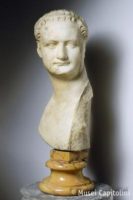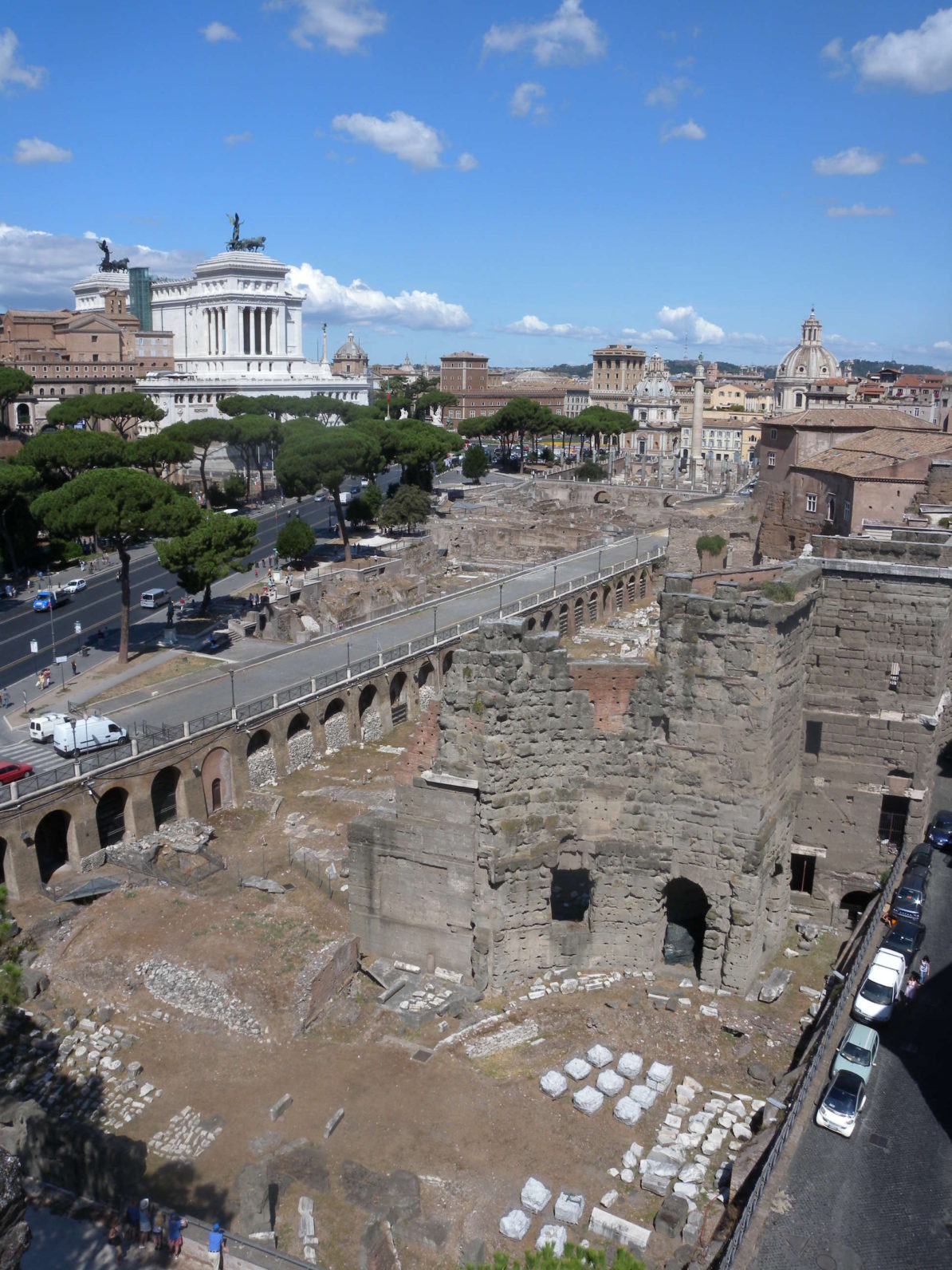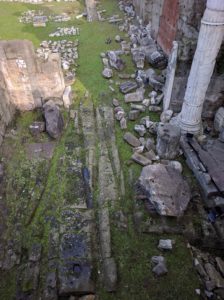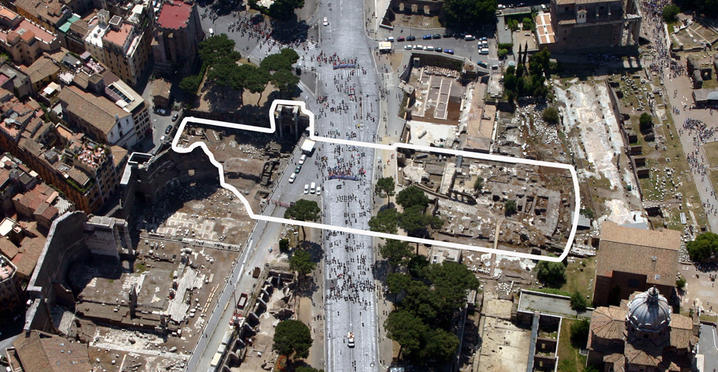
After the construction of the Forum of the Peace (75 A.D.), a long, narrow space remained between it and the more ancient Fora, that of Caesar (46 .AD.) and that of Augustus (2 B.C.). It was roughly 45×170 metres and was the last portion of the Argiletum, an ancient route that connected the Roman Forum with the Suburra quarter (the area that today is the Monti neighborhood).
The pre-existing Buildings and the Cloaca Maxima
The area was occupied with mostly commercial building and by the cumbersome perimeters of the two massive apses on the southern side of the Forum of Augustus. Underground ran the Cloaca Maxima, a monumental drainage pipe that tradition has it dated back to the period of the Kings of Rome, exactly from the 6th century B.C. This drainage system started in the Suburra, crossed the Roman Forum and the Velabrum valley and flowed into the Tiber river just below the Tiberina Island.
The True Founder of the Forum of Nerva: Domitian

On the basis of data from the most recent excavations and information furnished by Classical authors it is possible to establish that the transformation of this segment of the Argiletum into a forum took place due to the Emperor Domitian (81-96 A.D.) and that possibility already in the years 85-86 A.D. the new complex had assumed a very definite appearance. Nevertheless, Domitian was assassinated in 96 A.D. and thus could not inaugurate his new Forum, something that the following year his successor, Nerva (96-98 A.D.) accomplished. It is for that reason that the Forum is known as the Forum of Nerva.
The Architecture of the Forum
The piazza that was formed was 114 metres long and only 45 metres wide, with boundary walls made of blocks of tufa. At the centre of the short side to the east, towards the Suburra, a temple was placed. It was dedicated to Minerva, a deity that was, not surprisingly, the protector of Domitian. Along the main sides of the piazza was a protruding colonnade because the available space was so limited as to impede the construction of normal porticoes like those in the other Fora. On the contrary, in order to have sufficient space available, it was necessary to demolish the western hemicycle of the Forum of Augustus. Instead, the eastern hemicycle was preserved and hidden by the Temple of Minerva, that leaned against it.

The Porticus Absidata
The buttressing of the Temple of Minerva with the apse of the Forum of Augustus was hidden on the back side of the Temple itself by a horse-shoe shaped structure: the so-called Porticus Absidata; it was made up of a grand portico that served as entrance to the Forum from the Suburra. From the Porticus, of which few ruins of pillars in tufa remain today, one entered into the piazza of the Forum through a monumental arch that since the Middle Ages has been called the ‘Arco di Noè’ (Arch of Noah), probably a corruption of the name Arcus Nervae (that means: Arch of Nerva).

The Eastern Part of the Forum: the Podium of the Temple and a Medieval Street

Today both the eastern and western extremities of the Forum of Nerva are still visible, while the central part of the piazza lies unexplored beneath the Via dei Fori Imperiali. The eastern sector of the Forum was excavated between 1932 and 1942. Immediately next to Via Alessandrina one can observe the remains of the Temple of Minerva. Part of the imposing foundations in concrete and flint are visible along with rows of tufa blocks and travertine which made up the podium above. To the right of the podium is a portion of road scored with deep ruts. This is the external part of the covering of Cloaca Maxima made of tufa blocks upon which the ancient pavement of Forum rested. During the Middle Ages, these slabs of stone were taken away and the wheels of the carriages that passed by etched the blocks of tufa, thus creating the ruts we see today.

The Outside Wall of the Forum and the “Colonnacce”
The ancient road passed between the Temple (which was demolished at the beginning of the 17th century) and the only remaining segment of the ancient external wall of the Forum which has built of blocks of tufa. Leaning against the wall, and still intact after more than nineteen centuries, are two of the more than 50 columns that decorated the sides of the piazza. They are called the “Colonnacce” (something like “bad columns”), because of their state of ruin. The entablature above the Colonnacce bears a carved frieze that initially ran for hundreds of metres along the perimeter of the Forum. Today only 25 metres remain and one can observe 61 figures divided into eight scenes which depict episodes from mythology that centre around the Goddess Minerva.

The Story of Arachne and the Personification of a Subjugated People
In particular, one can recognize the story of Arachne, recounted by Ovid in his Metamorphoses. This young maiden had dared to challenge and beat Minerva at the art of weaving and for this was punished by the goddess by being transformed into a spider (aracne in Ancient Greek). Above the frieze is a relief that shows a female figure with a helmet and shield. This has always been interpreted as an image of Minerva, however recently it has instead been identified as the personification of the Pirusti, an ancient population from the Balkan peninsula that was subdued by the Romans. The discovery of fragments of at least two other similar figures (one is displayed at the Museum of the Imperial Fora) has led to the hypothesis that the ancient Forum was decorated with personifications of the peoples that made up the Roman Empire.
The Western Part of the Forum
The western section of the Forum of Nerva was excavated and brought to light in the last decades of the 20th century. No standing structures from the Forum were found, only remains of the slabs of marble from the pavement, most of which were remade at the beginning of the 5th century. Important discoveries were made underneath the piazza, and represent the remains of numerous pre-existing structures. The most noteworthy was identified as the foundation of a temple of similar size to the Temple of Minerva that however was never completed, or if had been, either collapsed or was demolished shortly after being built. It appears that as a response to these difficulties, it was decided to build a new temple on the other side, where the Temple of Minerva was actually built.
Of particular interest was the discovery in this same area of the Forum of two noble residences dating from the 9th century AD, both examples of upper-class constructions from the High Middle Ages.

